M. Isidora Forrest's Blog, page 7
November 3, 2024
Does Isis Ever Speak to You in Poetry?
For some of us, poetry is one of the ways in which we can express our feelings or experiences with the Divine. Whether we compose it ourselves or discover a poem that has the perfect words to touch our hearts and say what we’d want to say.
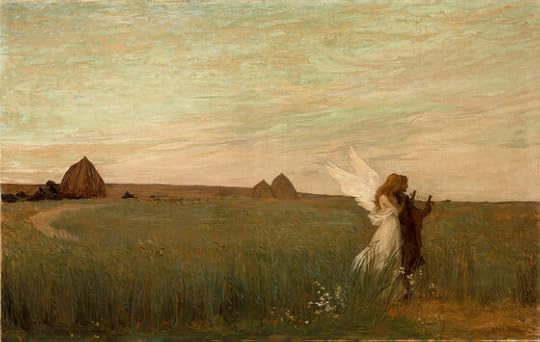 Hesiod Listening to the Inspiration of the Muse; Edmond-François Aman-Jean, French, 1890
Hesiod Listening to the Inspiration of the Muse; Edmond-François Aman-Jean, French, 1890It isn’t easy to be a poet. You can wrestle with words for days and still come up empty-handed. I find that if I just sit down with the intention of writing a poem about Isis, I get—well—pretty much nothing.
The way it works best for me, is to poise my fingers over the keyboard, clear my mind, close my eyes, invoke the Goddess…and start typing. (The trick is keeping your fingers over the right keys. Otherwise you get rhwewosqeonger.)

What comes out is by no means finished. It’s more like notes for a poem. Then I work with it and shape it, making it into something, and in that process discover its meaning—for me, for now.
The value of this for me is that I often get images that I would not have come up with in my normal state of consciousness. Sometimes, they don’t even make logical sense, but they do make a kind of poetic sense. They can be odd and beautiful. Sometimes I edit out the strangenesses. Sometimes I just leave them in, hoping that they’ll communicate what the Goddess intended.
To show you what I mean, I’m going to do a little experiment right now. [NOTE: This is a repost. But when I first wrote it, it was done “live” and in real time.]
So here we go. Fingers poised over keyboard…opening…invoking…and typing this:
long black wings against a blue white sky clouds bending into circles interpenetrating the blackness of feather of feature of faith clean sharp shriek of light coming into my mind clearing feathered fog leaving its own breath I am hearing you now
That’s what it looks like first out of my brain, and inspired in whispered hints from some Muse-form of Isis. It sort of reminds me of Symbolist poetry from the late 19th/early 20th century.
Now, I’ll break it up into phrases and add punctuation as remembered from my mental “hearing” of it:
Long black wings against a blue-white sky. Clouds bend into circles, interpenetrating the blackness of feather, of feature, of faith. A clean, sharp shriek of light comes into my mind, clearing feathered fog and leaving its own breath. I am hearing you now.
I’m starting to understand what this is about. It’s about the subject of this post—receiving poetic inspiration from the Goddess. So it is an image of what that inspiration can be like.
Now, working with it a bit more, I get this:
Long, dark wings flash against a purified sky. Blue-white ghost clouds move and spiral, interpenetrated by the blackness of feather, of feature, of faith. In my mind, a clean, sharp shriek of light clears feathered fog, leaves its own breath. I am hearing you now.
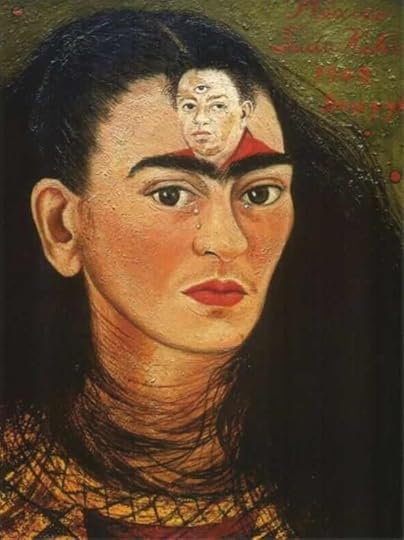 Diego y yo, Frida Kahlo; Frida and Diego served as muses for each other
Diego y yo, Frida Kahlo; Frida and Diego served as muses for each otherI’ll leave this as it is for now. If I had intended to keep this, I would probably work with it a bit more. It’s not quite there yet, but it’s just a quick example of what the Goddess might inspire.
Now, art of any kind isn’t quick and easy. In fact, it takes time and practice. But if you are at all inclined, I’d urge you to try it. In your own way, of course. And in your own medium. Maybe you’ll paint instead. Maybe you’ll sing. But however it comes to you, don’t be concerned with the perfection of your results. She doesn’t care about that. Isis will always gladly take your work as an offering of devotion and love.
(I have a question about this little bit of Isis poetry: That final phrase, “I am hearing you now.” Is that the poet hearing the Goddess, or the Goddess hearing the poet? What do you think?)
October 27, 2024
Syncretism & Isis
 A Roman Isis
A Roman IsisThe worship of Isis is one of the most important examples of religious syncretism in the world. Whenever the topic of syncretism arises, you will inevitably find a discussion of Isis included.
When it comes to religion, talking about syncretism often centers on whether it is a good thing or a bad thing.
But maybe, syncretism just is—unless a culture or religion is completely isolated. Because anytime peoples and cultures and religions encounter each other, there has always been—among at least some of those peoples and cultures and religions—some form of syncretism.
 The Isis keystone on the Egyptian Museum in Cairo
The Isis keystone on the Egyptian Museum in CairoAnd yes, of course, you’re right; it’s time for a definition. So, what is syncretism?
When we look at the various definitions, we see that it is usually said to be the combining, attempting to unify, assimilating, blending, fusing, reconciling, harmonizing, mixing, and other similar terms, the various aspects of two or more religions or Deities. Sometimes, religious syncretism is called theocrasia, Greek for “God-mixing.”
At the time of the rise in the popularity of the worship of Isis, interchanges between Egyptian, Greek, and Roman cultures— trade, technologies, philosophies, and yes, spiritualities—were also flourishing.
The influence of those cultures upon each other is often given as a primary example of syncretism on a broader scale. The ancient Egyptian city of Alexandria is an example of a highly syncretic—or we might say, multicultural or diverse—city. Christianity, also developing at about the same time as the spread of Isis’ worship, is another example of a syncretic worship, both in its origins and in its much later expressions, as it absorbed and transformed many of the Pagan traditions it encountered, forcibly or not.
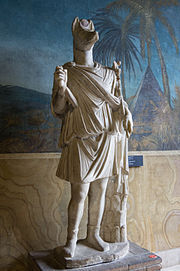 Anubis in Roman garb
Anubis in Roman garbThose who consider religious syncretism bad generally point to a “watering down” of the original tradition; there is also a legitimate concern with appropriation. Those who say religious syncretism is good generally associate it with positive innovation in religion rather than corruption. Others suggest that we retire the term entirely, because this kind of mixing is simply inevitable. Yet others prefer to retain the term since studying how it happens is valuable in researching the development of many of the world’s religions.
Interestingly, it may have been the Greek priest Plutarch—who wrote down a Greek narrative version of the Egyptian myth of Isis and Osiris—who coined the term syncretism. He used it to describe how the various Cretan tribes came together as one when faced with external threats. So, for him, it was positive mixing toward a greater good for Crete.
 Isis of Coptos, wearing the Horns & Disk crown associated with Hathor
Isis of Coptos, wearing the Horns & Disk crown associated with HathorSyncretism was one of the ways Isis gained many of Her 10,000 names. Yet this all started within Egypt itself.
Those of you who have been following along with this blog already know how the Egyptian Deities are liable, at most any time, to morph into each other, to combine with each other, or to appear as each other. It is—as I have said so many times that you’re tired of reading it—one of my favorite things about the ancient Egyptian conception of the Divine. It is fluid. It can change. It can show Itself to us in myriad forms. For me, this fluidity is a genuine reflection of the Divine nature.
Egyptian combinations of Deities could demonstrate similarity: Isis-Hathor. Another might enable a Deity to express power in a specific way: Isis-Sakhmet. Mostly, in Egypt, Goddesses could flow only into other Goddesses, Gods into other Gods. Isis is unusual in that She could combine with Gods as well. We find an Isis-Anubis in the later mythological texts, as well as an Isis-Horus.
 An image of Demeter, but with the tiny horns of Isis-Io upon Her forehead
An image of Demeter, but with the tiny horns of Isis-Io upon Her foreheadIn this way, Isis could be almost any other Egyptian Goddess as well as some Gods. We discover many of Her names in the which gives us Her names and epithets, first within Egypt, then throughout the Mediterranean.
Outside of Egypt, one of the first important Deities Isis is syncretized with is the Greek Great Goddess Demeter. This went as far back as the 5th century BCE when the historian Herodotus declared that Isis IS Demeter and that Isis and Osiris were the only Deities worshiped throughout all of Egypt. (This wasn’t strictly true, but that was his impression.)
The Isis myth, as recorded and interpreted by Plutarch, gives us the perfect example of a syncretic myth.
As Plutarch tells it, the wanderings of Isis include episodes similar to those in Demeter’s story of wandering in search of Persephone. Like Demeter, Isis (in disguise as a human woman) weeps at a spring (in Demeter’s case, a well) and is invited into the royal house to be the nurse of a royal infant. At night, She tempers the child in a fire, making him immortal.
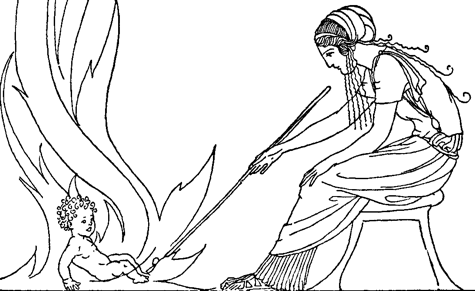 Demeter immortalizing Demophon
Demeter immortalizing DemophonOne night, the queen sees this process and, quite understandably, screams bloody murder, thus interrupting the magic and prohibiting her child from gaining immortality.
But let’s go one step further into this particular syncretism. Some Egyptologists believe that this “burning baby” episode may actually have originated in Egypt—with what they call the “burning Horus” formula—and from there it was imported into Demeter’s myth. So, in this case, both cultures were inspired by the other and each added a detail from the other Great Goddess’ myth to their own story.
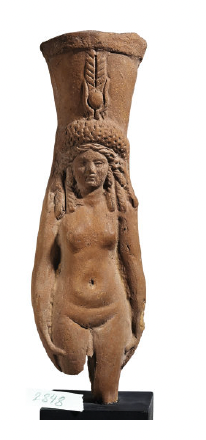 Isis-Aphrodite
Isis-AphroditeThere are numerous images that show Isis combined with Goddesses other than Demeter from throughout the Mediterranean region. We find Isis-Aphrodite, Isis-Astarte, Isis-Selene, Isis-Sophia, Isis-Artemis, Isis-Rhea, Isis-Fortuna, and many more. Just as She had within Egypt, now Isis flowed into Goddesses far beyond Egypt. So much so that She eventually became THE Goddess to many people, both within and without Her native land.
The human pathos of Isis’ story, Her fierceness in defending both Her husband and Her child, Her powers of resurrection and rebirth, and the magic that always clings to Isis like a potent perfume—all contributed to the spread of Her religion in the Greco-Roman world. People saw Her in their own Goddesses and they saw their own Goddesses in Her, eventually adopting Her as their own. Syncretism.
For today, I’d like to leave you with a syncretic hymn to Isis. It is one of four written in Greek and carved on the temple of Isis-Hermouthis (Hermouthis is a Hellenized form of the Cobra Goddess Renenutet) in the Egyptian Faiyum, where She was paired with the Crocodile God Sobek. The hymn was written by a man named Isidorus; judging by his name, he was at least a devotee. He may have been a native Egyptian who was either given or adopted a Greek name. Some researchers even think he could have been a priest of Isis, but we just don’t know.
Here is one of his four Faiyum hymns to Isis:
 Isis-Hermouthis
Isis-HermouthisO wealth-giver, Queen of the Gods, Hermouthis, Lady,
Omnipotent Agathē Tychē [“Good Fortune”], greatly renowned Isis,
Dēo, highest Discoverer [generally, this means “creator”] of All Life,
Manifold miracles were Your care that You might bring livelihood to mankind and morality to all.
You taught customs that justice might in some measure prevail;
You gave skills that men’s life might be comfortable,
And You discovered the blossoms that produce edible vegetation.
Because of You, heaven and the whole earth have their being; and the gusts of the winds and the sun with its sweet light.
By Your power the channels of Nile are filled, every one,
At the harvest season and its most turbulent water is poured
On the whole land that produce may be unfailing.
All mortals who live on the boundless earth,
Thracians, Greeks, and Barbarians,
Express Your fair Name, a Name greatly honored among all, but
Each speaks in his own language, in his own land.
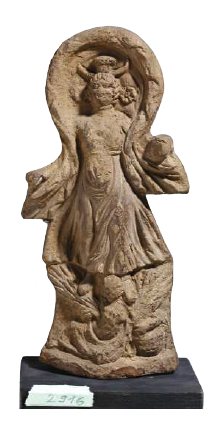 Isis-Demeter-Selene
Isis-Demeter-SeleneThe Syrians call You: Astarte, Artemis, Nanaia [Mesopotamian Love Goddess closely associated with Inanna];
The Lycian tribes call You: Leto, the Lady;
The Thracians also name You as Mother of the Gods;
And the Greeks call You Hera of the Great Throne, Aphrodite,
Hestia the Goodly, Rheia and Demeter.
But the Egyptians call You Thiouis [from Egyptian Ta Uaet, “the Only One”] because they know that You, being One, are all other Goddesses Invoked by the races of men.
Mighty One, I shall not cease to sing of Your great Power.
Deathless Savior, many-named, mightiest Isis,
Saving from war cities and all their citizens: men, their wives, possessions, and children.
As many as are bound fast in prison, in the power of death;
As many as are in pain through long, anguished, sleepless nights,
All who are wanderers in a foreign land,
And as many as sail on the Great Sea in winter
When men may be destroyed and their ships wrecked and sunk,
All these are saved if they pray that You be present to help.
Hear my prayers, O One whose Name has great Power; prove Yourself merciful to me and free me from all distress. —Isidorus wrote it*
If you would like to hear a poetic and profound piece on syncretic Deities, I invite you to listen to this episode of the wonderful podcast The Emerald: Let Us Sing of Syncretic Gods, of Outcasts and Wanderers. Yes, of course, Isis is mentioned.
*Translation from Vera Vanderlip, The Four Greek Hymns of Isidorus & the Cult of Isis.
October 20, 2024
Is Isis a Moon Goddess?
Last night, we held our All-Hallows Eve rite (a bit early, I know). As we welcomed our Honored Dead in the presence of the Dark Ones, many of us were very aware of the bright moon shining above, just two days past a full Hunters’ Moon.
The moon, the moon, the moon. And I am thinking now of the moon and Our Lady Isis.
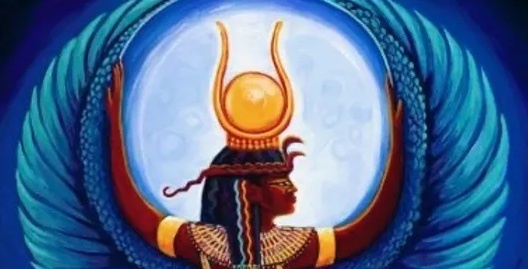
When we first encounter Isis, we often first discover Her as a lunar Goddess, a Goddess of the Moon. But is She?
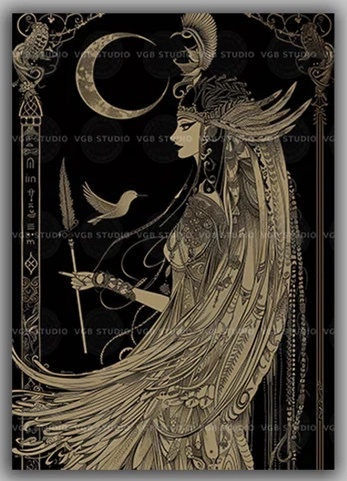 A lovely lunar Isis; you can purchase a copy of your own here
A lovely lunar Isis; you can purchase a copy of your own hereWell, that really kind of depends on when you ask.
If we’re asking for today, for now, then yes, She is. And She has been for more than a millennium. But She took a rather circuitous route to get there. So let’s follow that trail a bit and see how it happened.
Early in Egyptian history, Isis was firmly associated with the heavens—with the star Sirius in particular, and with the sun, too—but She was not considered a Moon Goddess.
Moon Gods were the norm for Egypt—Iah, Thoth, Khonsu, and Osiris are among the most prominent and the moon’s phases were quite important to the ancient Egyptians. Scholars generally agree that the first Egyptian calendars, like those of so many ancient people, were lunar based. The temples marked the moon’s changes and especially celebrated its waxing and full phases. But the face the Egyptians saw in the moon was masculine rather than feminine.
 The horns of the Moon Goddess rising
The horns of the Moon Goddess risingFor example, the waning and waxing of the moon could be associated with the wounding and healing of the Eye of Horus. So, perhaps we can think of Isis as the Mother of the Moon. Indeed, She was called “Isis, Who Creates the Moon Eye of Horus by Her Heart.” In some myths, Isis is the one Who heals Horus’ Eye, in others, it is Thoth or Hathor and we see this reflected in Isis’ epithet as She “Who Heals the Left Eye.”
By the time of the New Kingdom, the beloved of Isis, Osiris, becomes prominent as a lunar God. We have a number of examples of statuettes of Osiris-Iah—Osiris assimilated with Iah, a Moon God—or simply as Osiris the Moon. So in this case, Isis is married to the Moon. But She’s not really a Moon Goddess Herself.
On the other hand, the Greeks and the Romans were all about the Moon Goddess. In fact, the moon itself was simply called “the Goddess.” People spoke of doing something “when the Goddess rises.” They would kiss their hands, extending them toward the rising moon, “to greet the Goddess.” Magical texts give instructions for performing a certain ritual “on the first of the Goddess,” meaning at the new moon. When they saw Isis with Her horns-and-disk crown, they saw a Moon Goddess.
 The lunar Eye of Horus
The lunar Eye of HorusAnd because we have so much information about Isis from these Moon Goddess-loving people, today when many people think of Isis, the moon is one of the first things they associate with Her. Yet, interestingly, it seems to have been a third century BCE Egyptian priest named Manetho who first connected Isis with the moon. By the following century, when Plutarch recorded the most complete version of the Isis-Osiris myth we have, the tradition of Isis as a Goddess of the Moon was firmly established—even in Egypt.
Of course, it was easy to associate the fertility-bringing moon with the fertile Mother Isis. The ancient world also associated love affairs with the moon (the romance of moonlight, you know) and, in Her passion for Osiris, Isis was a famous lover.
 A Roman Isis with lunar crescent
A Roman Isis with lunar crescentOf course, the moon and the obscuring darkness of night were connected with magic, too—and Isis was one of Egypt’s Mightiest Magicians from the beginning. She was called Lady of the Night. One Egyptian story told how a particular magical scroll—which the tale calls a “mystery of the Goddess Isis”—was discovered when a moonbeam fell upon its hiding place, enabling a lector priest in Isis’ temple to find it.
Today, we also connect the moon with emotions, the deep, the waters, the feminine (taking our cue from the ancient Greeks and Romans), the home, Mystery, and change (to name but a few). And Isis can definitely be associated with all of these things—from the emotional passion of Her myths to Her ancient Mysteries and Her enduring role as the Goddess of Regeneration and Transformation.
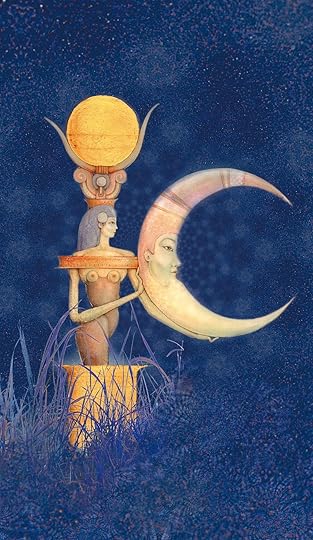 This beautiful lunar Isis is by Reinhard Schmid. You can see his work here
This beautiful lunar Isis is by Reinhard Schmid. You can see his work hereSo is Isis a Moon Goddess? She certainly has been for a very, very long time. Whether we choose to honor Her in this form has more to do with us than with Her. Many contemporary Pagans will probably be quite comfortable working with Isis as a Moon Goddess; a strict Kemetic Reconstructionist, not so much. But Isis is a Great Goddess; She is All, and so, for me, She is unquestionably to be found in the deep and holy Mysteries of the Moon.
And yet, and just for myself, while I do find Her in the moon, I resonate most strongly with Isis of the Stars and Isis of the Eternities of Space and Isis the Radiant Sun Goddess. Nevertheless, I still feel the call to explore Her important lunar aspects. What about you?
October 13, 2024
Isis and…Samhain? Really?

We gazed at the waning light of the moon last night.
Its cool, pale light was beautiful, and yet sad. That’s often how this time of year feels. Beautiful. And sad. For at this time of year, many of us remember our Beloved and Honored Dead.
 My favorite Osiris rising
My favorite Osiris risingSome of us might celebrate the solemn rites of Samhain—from a quite different culture than that of ancient Egypt. (In my community, we’ll celebrate our rites next weekend.)
Now, of course you’re quite right that the ancient Egyptians did not celebrate Samhain. Yet we know they honored their dead. Indeed, their dead could be very, very present for them, as transfigured spirits, akhu, who could help them in their day-to-day lives—or cause them trouble.
But for Isis devotees seeking a more Egyptian way to mark this time of year, I’d like to introduce you to the Isia.
A festival called the Isia is found in a calendar from 354 CE that was commissioned by a wealthy Roman Christian named Valentinus from a prominent, also-Christian scribe named Philocalus. The Calendar of Philocalus is famous because it contains the first known reference to the Christian holiday of Christmas as an annual festival of the birth of the Christ on December 25th. (There are earlier references to that date, but not as an annual festival.)
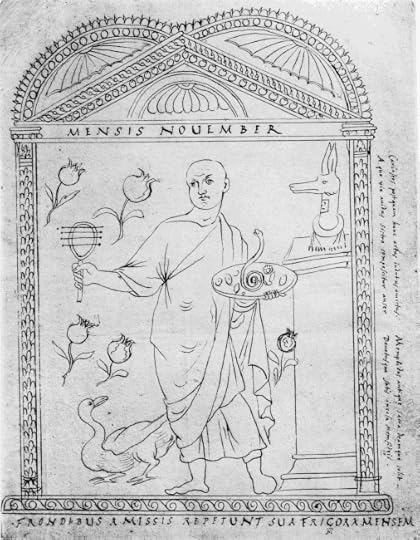 An illustration of November from Philocalus’ 354 CE calendar; note the sistrum and Anubis head
An illustration of November from Philocalus’ 354 CE calendar; note the sistrum and Anubis headBut for Isiacs, the calendar is important for its inclusion of a different festival: the Isia. Philocalus records the dates of the Isia as October 28th-November 1st. Some scholars also include the days until November 3rd as part of the Isia. That’s because Philocalus’ calendar has what was known as an “Egyptian Day” on November 2nd and a Hilaria on November 3rd, both of which may have been included in the Isia.
Let me explain: to the Romans, an “Egyptian Day” was a bad luck day. There were three in January and two in every other month. The first Egyptian Day in November fell right after the Isia, on November 2nd. These days were inappropriate for public festivals, sacrifices, and were generally stay-in-your-house-and-do-nothing days. The bad luck of the Egyptian Days continued on into medieval Christian calendars.
Why were they called “Egyptian” days? No one knows for certain. However, Egyptian calendars (for example, the famous New Kingdom Cairo Calendar) often list festivals along with auspicious and inauspicious days. So it may well be that Romans simply picked up these genuinely Egyptian bad luck days and put them into their own calendar. (This tells you how influential the worship of The Egyptian Gods—mostly Isis and Sarapis—were.) Later on, the name was taken to refer to the ten biblical plagues of Egypt to better harmonize these pagan-y days with scripture.
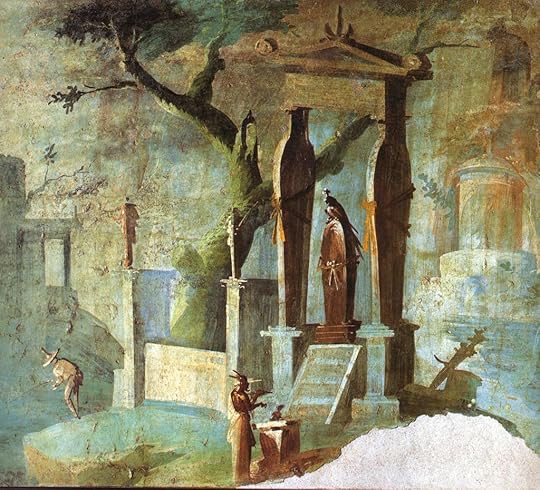 From Pompeii: Making offering before the sarcophagus of Osiris
From Pompeii: Making offering before the sarcophagus of OsirisAs for the Hilaria, there are two shown on Philocalus’ calendar, one on March 25th, at the end of a lengthy festival of Magna Mater/Kybele in which the death of Attis is mourned. The preceding day (the 24th) was the Day of Blood, on which flagellation and self-castration might take place, and it was also an Egyptian Day. The Hilaria was what it sounds like: a day of joy. People played games and feasted. Some scholars think that the spring Hilaria could be the origin of our April Fool’s Day.
So clearly, it was not absolutely unheard of to have a festival on an Egyptian Day…of course in the case of the Kybele festival, it was the (yikes!) Day of Blood. There is nothing else listed in Philocalus’ calendar for the Egyptian Day following the Isia. The November Hilaria is shown as the day after that, on the 3rd.
Yet in both cases, we have a Great Goddess with a partner to be mourned, followed by a Day of Joy. This makes very good sense from a psychological standpoint; we need relief after mourning. So it may be that we should include the Egyptian Day and the Hilaria following the Isia as part of the Isia festival after all. Which would mean that (here in the northern hemisphere) we’re approaching the festival right now. So there’s time to prepare should you choose to celebrate your own Isia.

Artist’s depiction of ceremonies at the Temple of Isis, Pompeii. Click to see it larger.
We know little else about the Roman Isia. On one hand, this frees us to create our own Isia. Given the time of year, we might choose to connect the Isia with the modern festival of Halloween. Isis is, after all, a Goddess of the Dead par excellence. There is much we could do with an Isia in which we remembered our own Honored Dead, for example by speaking their names and making offering in the ancient Egyptian tradition.
On the other hand, there is an appropriate Egyptian option for the celebration of the Isia and—and given the timing and the resonant subject matter—it is a likely candidate for the basis of the Roman Isia.
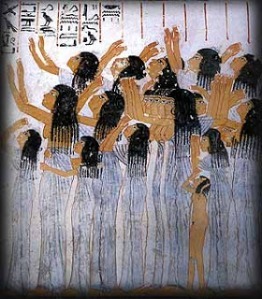 Mourning for Osiris
Mourning for OsirisThough perhaps it should more rightly be called the Osiria. For at about this same time of year, in the Egyptian month of Khoiak, the ancients held a festival for Osiris that remembered His conflict with His brother Set, His death, and His resurrection through the holy magic of Isis. We know of this festival from the period of the Middle Kingdom and have a decent record of it from the great Osirian sanctuary of Abydos. We also know of it from the Osiris chapel in Hathor’s Ptolemaic sanctuary at Denderah.
The festival re-enacted the central Isis-Osiris myth (I won’t recount it here; you all know the story.) The Egyptians molded images of Osiris from Nile mud, special spices, talismanic stones, and seeds. The images were watered so that the grain sprouted, a fitting symbol of new life. (We should also know that this was about the time of year when the Nile flood was receding so that the fields could be planted with new crops.) The festival ended with the raising of the Djed pillar, symbol of the resurrection of the God Himself as Lord of the Otherworld.
If you are so inclined, now is a perfect time to re-enact that core Isiac myth—if on a smaller and more personal scale. And should you do so from Isis’ point of view, it would be a true Isia, indeed.
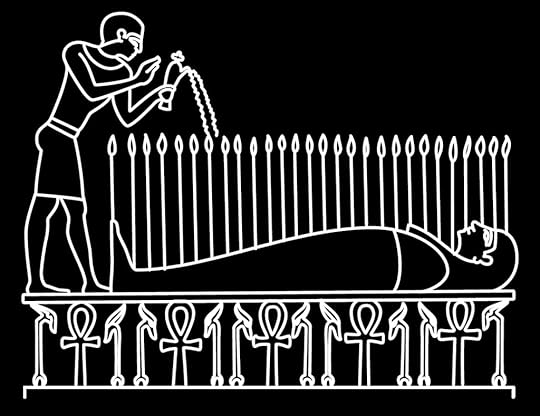 Watering the grain in the sacred image of Osiris
Watering the grain in the sacred image of OsirisI have done my own private Isia like this: I shuffle and deal out 14 Tarot cards, representing the 14 parts of the body of Osiris. I place or “hide” the cards in a circle around my temple. Then, during the several days of the festival, I ritually circle the temple, “finding” some of the cards until I have “found” them all. Then I assemble them into a roughly human-shaped, stick-figure Osiris. (This is a fairly large spread, so I place it in the middle of the floor of my temple.) On the last day of the festival, I turn over the cards, revealing them, and read them as an omen for the coming season and coming year. Naturally—to expand the rite and get myself in the proper magical frame of time, I use temple openings and closings of my choice from Isis Magic. (The Opening of the Ways works quite well; if you haven’t got your own copy of Isis Magic, you’ll find the ritual here.)
Should you decide to honor the Isia this year—in this way or some other—I would love to know about your experience. Whether you choose to connect your Isia with the ancient Khoiak festivals of Isis and Osiris, create a Day-of-the-Dead-type Isia, or celebrate some other way entirely, I wish you much depth and beauty in this darkening season of sad, sweet remembrance. May She embrace you always.
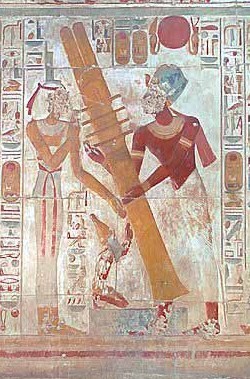
Isis and the pharaoh raise the Djed pillar, the symbol of the resurrection of Osiris
October 6, 2024
All My Divine Ones are Wine Deities
Oh yes, Isis is Lady of Wine and Beer. And yes, Osiris is Lord of Wine. And yes, Isis’ Philae temple owned vineyards. (Indeed many ancient Egyptian temples had their own vineyards, producing both white and red wines.)

But today…today, it’s harvest time at the Hallows in our backyard vineyard. And we, along with a glorious gaggle of all our beloved friends, are picking and crushing the Syrah grapes from our backyard arbor. We are feasting and dancing and gathering around the fire.
We are making wine.
We are making wine in honor of the Hallows’ other household God: Dionysos, Lord the the Vine and Bringer of Ecstasy. And so, right now, I am busy testing the grape must and measuring the sugars and adding the yeasts and feeding the ever-so-magical tiny transformers of juice into wine. I am up to my ears in hydrometers today. So, instead of a long post, I shall share with you some Bakchic inspiration.
From our Divinely mad harvest to yours—may all your harvests be rich, in this season and every season.
 We hand harvest with baskets and clippers
We hand harvest with baskets and clippers
 He always shows up
He always shows up
 Yes, of course, we look exactly like this
Yes, of course, we look exactly like this
 We DO actually look like this
We DO actually look like this
 We are drinking the 2021 Hallows Dionysian Syrah
We are drinking the 2021 Hallows Dionysian Syrah
 AccurateMay all your wine be delicious
AccurateMay all your wine be delicious
September 29, 2024
The Magical Hair of Isis
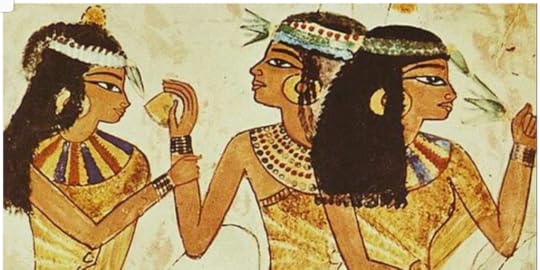
We are not immune to the charms of a beautiful head of hair—and the ancient Egyptians weren’t either.
But they took appreciation for hair, especially feminine hair, to a whole new level of magnitude. For them, hair was magical. And, of course, Who would have the most magical hair of all? The Goddess of Magic: Isis Herself.
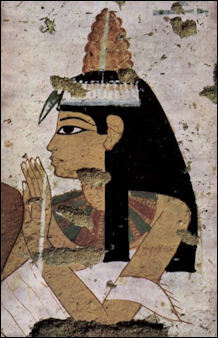 The charm of beautiful hair
The charm of beautiful hairI have always understood that the long hair of Isis in Egyptian tradition—disarrayed and covering Her face in mourning or falling in heavy, dark locks over Her shoulders—to be the predecessor of the famous Veil of Isis of later tradition. Ah, but there is so much more.
In ancient Egypt, it was a mourning custom for Egyptian women to dishevel their hair. They wore it long and unkempt, letting it fall across their tear-stained faces, blinding them in sympathy with the blindness first experienced by the dead. As the Ultimate Divine Mourner, this was particularly true of Isis. At Koptos, where Isis was notably worshipped as a Mourning Goddess, a healing prayer made “near the hair at Koptos” is recorded. Scholars consider this a reference to Mourning Isis with Her disheveled and powerfully magical hair.
 Mourners use various mourning gestures and dishevel their hair
Mourners use various mourning gestures and dishevel their hairIt is in Her disheveled, mourning state, that Isis finally finds Osiris. She reassembles Him, fans life into Him, and makes love with Him. As She mounts His prone form, Her long hair falls over Their faces, concealing Them like a veil and providing at least some perceived privacy for Their final lovemaking. As the Goddess and God make love, the meaning of Isis’ hair turns from death to life. It becomes sexy—remember those big-haired “paddle doll” fertility symbols?
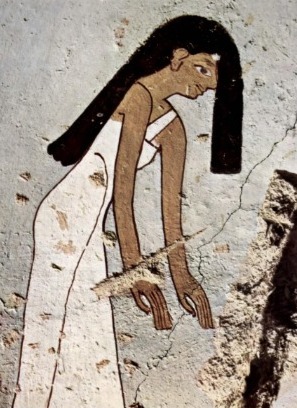 A mourning woman with her hair over her face from the tomb of Minnakht
A mourning woman with her hair over her face from the tomb of MinnakhtThis pairing of love and death is both natural and eternal. How many stories have you heard—or perhaps you have a personal one—about couples making love after a funeral? It’s so common that it’s cliché. But it makes perfect sense: in the face of death, we human beings must affirm life. We do so through the mutual pleasure of sex and, for some couples, the possibility of engendering new life that sex provides. The lovemaking of Isis and Osiris is the ultimate expression of this. Chapter 17 of the Book of Coming Forth by Day (aka the Book of the Dead), describes the disheveled hair of Isis when She comes to Osiris:
“I am Isis, you found me when I had my hair disordered over my face, and my crown was disheveled. I have conceived as Isis, I have procreated as Nephthys.” (Chapter 17; translation by Rosa Valdesogo Martín, who has extensively studied the connection of hair to funerary customs in ancient Egypt.)
There is also a variant of this chapter that has Isis apparently straightening up Her “bed head” following lovemaking:
“Isis dispels my bothers (?) [The Allen translation has “Isis does away with my guard; Nephthys puts an end to my troubles.]. My crown is disheveled; Isis has been over her secret, she has stood up and has cleaned her hair.” (Chapter 17 variant, translation by Martín, above.)
This lovemaking of Goddess and God has cosmic implications for its result is a powerful and important new life: Horus. As the new pharaoh, Horus restores order to both kingdom and cosmos following the chaos brought on by the death of the old pharaoh, Osiris.
Not only is hair symbolic of the blindness of death and the new life of lovemaking; the hair of the Goddesses is actually part of the magic of rebirth. Isis and Her sister, Nephthys, are specifically called the Two Long Haired Ones. The long hair of the Goddesses is associated with the knotting, tying, wrapping, weaving, knitting, and general assembling necessary to bring about the great Mystery of rebirth. Hair-like threads of magic are woven about the deceased who has returned to the womb of the Great Mother. The Coffin Texts give the name of part of the sacred boat of the deceased (itself a symbolic womb) as the Braided Tress of Isis.
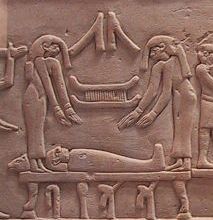 Mourners, probably Isis and Nephthys, throw Their hair over the Osiris
Mourners, probably Isis and Nephthys, throw Their hair over the OsirisIn some Egyptian iconography, we see mourning women, as well as the Goddesses Isis and Nephthys, with hair thrown forward in what is known as the nwn gesture. Sometimes they/They actually pull a lock of hair forward, especially toward the deceased, which is called the nwn m gesture. It may be that this gesture, especially when done by Goddesses, is meant to transfer new life to the deceased, just as Isis’ bed-head hair brought new life to Osiris. It is interesting to note that the Egyptians called vegetation “the hair of the earth” and that bare land was called “bald” land, which simply reiterates the idea of hair is an expression of life.
Spell 562 of the Coffin Texts notes the ability of the hair of Isis and Nephthys to unite things, saying that the hair of the Goddesses is knotted together and that the deceased wishes to “be joined to the Two Sisters and be merged in the Two Sisters, for they will never die.”
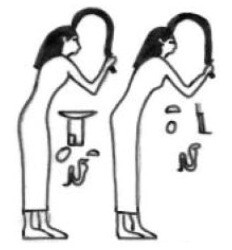 Isis and Nephthys pull a lock of hair toward the deceased
Isis and Nephthys pull a lock of hair toward the deceasedThe Pyramid Texts instruct the resurrected dead to loosen their bonds, “for they are not bonds, they are the tresses of Nephthys.” Thus the magical hair of the Goddesses is only an illusory bond. Their hair is not a bond of restraint but rather the bonding agent needed for rebirth. Like the placenta that contains and feeds the child but is no longer necessary when the child is born, the reborn one throws off the tresses of the Goddesses that had previously wrapped her or him in safety.
The Egyptian idea of Isis as the Long-Haired One carried over into Her later Roman cult, too. In Apuleius’ account of the Mysteries of Isis, he describes the Goddess as having long and beautiful hair. Her statues often show Her with long hair, and Her priestesses were known to wear their hair long in honor of their Goddess.
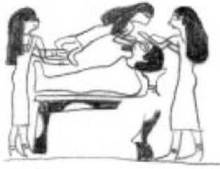 This is sketched from a coffin from Gebelein, 13th dynasty where either a long-haired female image or a long-haired female is spreading her hair over the deceased.
This is sketched from a coffin from Gebelein, 13th dynasty where either a long-haired female image or a long-haired female is spreading her hair over the deceased.This little bit of research has inspired me to want experiment with the magic of hair in ritual. In Isis Magic, the binding and unbinding of the hair is part of the “Lamentations of Isis” rite (where it is very powerful, I can tell you from experience), but I want to try using it in some solitary ritual, too. I have longish hair, so that will work, but if you don’t and are, like me, inspired to experiment, try using a veil. It is most certainly in Her tradition. (See “Veil” in my Offering to Isis.)
If you want to learn more about the traditions around hair and death, please visit Rosa Valdesogo Martín’s amazing and extensive site here. That’s where most of these images come from…many of which I had not seen before. Thank you, Rosa!
I have her book on the subject on order, but the publisher has postponed its release several times. Here’s hoping it arrives sometime soonish.
September 22, 2024
Happy Autumnal Equinox 2024!
 Turquoise and carnelian—perfect Egyptian colors for fall.
Turquoise and carnelian—perfect Egyptian colors for fall.Here at the 45th parallel on the west coast of the US, we are perfectly situated to experience the turning of the seasons in a nearly archetypal form. Very often, the first day of autumn or winter or spring or summer turns out to be a ideal expression of the forthcoming season. Today, the first day of fall, is sunny, warmish but not hot, and the air shines with the gold that only autumn can bring. And it’s harvest time.
The crops are a bit late this year due to our weather; nonetheless, winter squash are in the farmer’s market and we’re just a few weeks away from our annual Dionysian Grape Stomp and Bacchanal, when we harvest the grapes in our own vineyard, dance them to juice, then feast and trance the night away.
Yet here, halfway from the equator to the top of the world, the seasons bear no relation to the seasons in ancient Egypt. For them, this would have been the second month of Inundation, when the Nile rose to cover the land, bringing its rich silt to Egyptian fields. Harvest time wasn’t until early Spring.
What’s an Isiac to do?
 The Two Sisters, here with symbols of the Two Lands
The Two Sisters, here with symbols of the Two LandsFor me, the answer is simple: when it comes to seasonal things, I celebrate locally. I am not trying to recreate the worship of Isis as it was in ancient Egypt; instead, I am inspired by those ancient roots of Her worship and yet feel perfectly free to grow from those beautiful, deep, and ancient roots new living plants. The seasons of the ancient Egyptians are not my seasons. And though this Egyptian Goddess is my Goddess, I cannot help but experience Her through my own modern cultural—and seasonal—lenses.
Thus, while the rite I will be participating in tonight, on this equinoctial evening, is not an ancient Egyptian rite, it honors one of the most important themes in ancient Egyptian life and spirit: duality. For tonight I shall make offering to the Two Sisters. Bright Isis and Dark Nephthys Who, when joined hand in hand, are an expression of the sacred magic of the equinox—the harmonious balance of light and dark, day and night.
 Isis & Nephthys as sisters. See more illustrations of this artist’s work here.
Isis & Nephthys as sisters. See more illustrations of this artist’s work here. The two Goddesses compliment each other in the light and dark children They bear to the same God. Osiris fathered the bright God, Horus, with Isis while with Nephthys, He fathered the dark God, Anubis. The Two Goddesses also manifest their Divine power differently. While Isis guides and sheds light on the hidden paths of the Otherworld, the Coffin Texts tell us that Nephthys speaks and they are obscured: “Hidden are the ways for those who pass by; light is perished and darkness comes into being, so says Nephthys.” While Isis summons the Barque of the Day, Nephthys is “a possessor of life in the Night-barque.”
 The Twins
The TwinsAnd yet, Isis and Nephthys are also and importantly twins. They are the Two Ladies, the Two Women, the Two Goddesses of the Hall of Truth, the Two Long-Haired Ones, the Two Uraeus Serpents, the Two Spirits, the Two Nurses, the Two Weavers, the Two Feathers, the Two Birds, the Two Cows, the Two Kites, the Two Divine Mothers, the Two Eyes of God, the Two Women, the Two Wise Ones, the Two Weepers, the Two Great, Great Ones, and ultimately, the Two Uniters. The essential balance and unity of Isis and Nephthys is expressed in the Graeco-Egyptian magical papyri by the name Isenephthys or Isis-Nephthys.
And so, in this time of perfect balance, I dance between the equal poles of night and day, teetering on the scales of Libra, and I honor the Two Ladies.
Blessed be the Ladies. Amma, Isenephthys.
September 15, 2024
Isis in All Her Names

In ancient Egyptian, there was a phrase that expressed the all-encompassing nature of Isis: Iset em Renus Nebu, “Isis in All Her Names.” By later periods of Her worship—within Egypt as well as throughout the Mediterranean world—Isis was understood as an All-Goddess Who could be seen in many other Goddesses. Her multi-faceted nature was expressed in a vast array of epithets attesting to Her Divine powers.
 Isis, the Myriad-Named One
Isis, the Myriad-Named OneWhen we enter into a relationship with a Deity, that Deity will inevitably expand for us as we learn more about Them and develop our understanding of Them. Perhaps we first greet Isis as protectress of Osiris and mother of Horus. But then we discover that Her power to do those things is because She is, first and foremost, Great of Magic. As we grow our relationship, She reveals more of Herself to us, She opens more doors to Her Divinity for us.
The same thing happened in ancient times. As She revealed ever more of Her Divinity to Her devotees, She became known, in Greek, as Myrionymos, “Myriad Named,” an almost precise echo of Her earlier Egyptian epithet.
So what I have for you today is an invocation of Isis in some of those myriad names and epithets. It is from one of the Oxyrhynchus papyri, which date roughly to the beginning of the 2nd century CE. For those who might like to look it up, this specific invocation is in Oxyrhynchus Papyrus XI.1380.
But first, let me tell you a bit about the papyri found in Oxyrhynchus, an ancient Egyptian city about ten days journey by water or five by land south of Memphis. The city was once quite beautiful, with colonnaded streets, temples, docks, and irrigated land out into the countryside. Outside of town were the city dumps. In the dumps, an enormous cache of ancient papyri was discovered. And because it never rains in this part of Egypt, everything that was above ground-water level was preserved, long after the city itself had crumbled to dust or been dismantled and reused as building materials. You’ll find more on the papyri here.
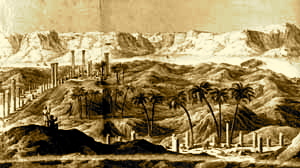 The town of Oxyrhynchus in Egypt in ruins
The town of Oxyrhynchus in Egypt in ruins
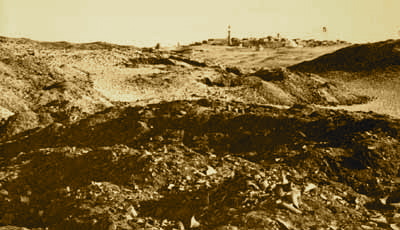 The garbage dumps of Oxyrhynchus, where the papyri were found
The garbage dumps of Oxyrhynchus, where the papyri were foundIn these papyri, we have everything from tax documents to personal letters to books to magical workings and invocations. Blessedly, we have an amazing Invocation of Isis in which She is invoked by Her names and epithets, first in the nomes and cities of Egypt, and then in other parts of the Mediterranean world. The Invocation goes on to offer praises to the Goddess. Scholars think it was written by an initiate of Isis, possibly a priest at Memphis. It was composed in Greek and it ranks as one of the most important Isiac documents ever found. And, of course, a great deal of it is missing. Sigh.
To make it easier to read, I’m going to leave out most of the triple dots (. . .) that indicate places where the papyrus was too damaged to read (except where that doesn’t make sense or is just too intriguing to leave out). Also, I’ll italicize the name or epithet, while leaving the place names un-italicized and break it into paragraphs, something the original does not do. The original was written in Greek, the lingua franca of the time.
The Oxyrhynchus Invocation of Isis the Many-Named Goddess
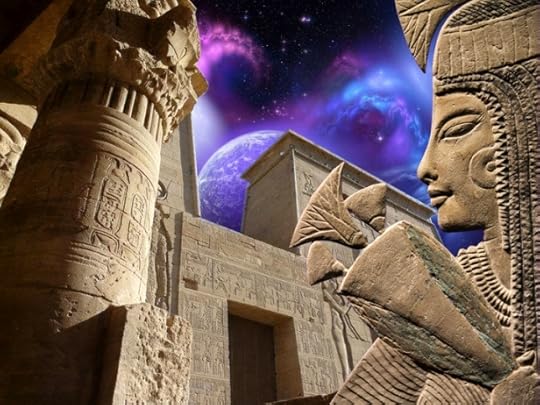 The first names are from towns in Egypt
The first names are from towns in EgyptI invoke Thee, Who at Aphroditopolis art called One; Who art called Bubastis; at Letopolis Magna, One; at Aphroditopolis in the Prosopite Nome, Fleet-Commanding, Many-Shaped, Aphrodite; at Delta, Giver of Favors; at Calamisis, Gentle; at Carene, Affectionate; at Niciu, Immortal, Giver; at Momemphis, Ruler, at Psochemis, Bringer To Harbor; at Mylon, Ruler; at Hermopolis, Of Beautiful Form, Sacred; at Naucratis, Fatherless, Joy, Savior, Almighty, Most Great; at Nithine in the Gynaecopolite Nome, Aphrodite; at Pephremis, Isis, Ruler, Hestia, Lady of Every Country; at Es, Hera, Divine; at Buto, Skilled in Calculation; at Thonis, Love; in the Saite Nome, Victorious, Athena, Nymph; at Caene, Joy; at Sais, Hera, Ruler, Perfect; at Iseum, Isis; at Sebennytus, Inventiveness, Mistress, Hera, Holy…
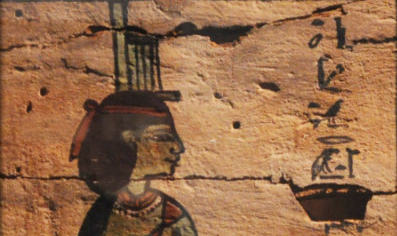 More Greek names for Egyptian towns
More Greek names for Egyptian townsAt Hermopolis, Aphrodite, Queen, Holy; at Diospolis Parva, Ruler; at Bubastus of Old, at Heliopolis, Aphrodite, at Aithribis, Maia, Supporter; at Hiera in the Phthemphuthite Nome, Lotus-Bearing; at Teouchis, Sacred, Mistress; among the Bucoli, Maia; at Xois of Old, Oracular; at Apis, Understanding; at Leuce Acte, Aphrodite, Mouchis [probably “She of Mouchis;” Mouchis was near Aphroditopolis], Eseremphis [Greek version of Egyptian name meaning “Isis the Year”]; at Choatine, Victorious; at …, Skilled in Writing; at Cynopolis in the Busirite Nome, Praxidice [a justice-bringing Goddess]; at Busiris, Fortune, Good; at Hermopolis in the Mendesian Nome, Leader; at Pharbaethus, Of Beautiful Form; at Isidium in the Sethroite Nome, Saviour of Men; at Heracleopolis in the Sethroite Nome, Mistress…
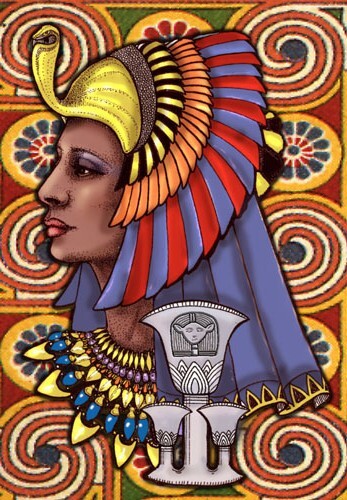 A beautiful image by the artist Zingaia. You can find her on Deviant Art.
A beautiful image by the artist Zingaia. You can find her on Deviant Art.At Phernouphis, Ruler of Cities; at Leontopolis, Serpent, Good; at Tanis, Of Gracious Form, Hera; at Schedia, Inventiveness; at Heracleum, Lady of the Sea; at Canopus, Leader of the Muses; at Menouthis, Truth; at Meniouis, Seated Before Io in Whose Honor . . . Is Founded; at M…Enestium, Most Great, Vulture-Sharped, Aphrodite; at Taposiris, Thauestis [unsure, but may be related to a popular Egyptian name, Thaues or Thauesis, meaning “Of Isis”] Hera, Giver; in the Island, Swiftly Victorious; at Peucestis, Pilot; at Melais, Many-Formed; at Menouphis, Warlike; in the Metelite Nome, Kore; at Charax, Athena; at Plinthine, Hestia; at Pelusium, Bringer To Harbor; in the Casian District Tachnepsis; at the Outlet, Isis, Preserver;
In Arabia, Great Goddess; in the Island, Giver of Victory in Sacred Games; in Lycia, Leto; at Myra in Lycia, Sage, Freedom; at Cnidus, Dispeller of Attack, Discoverer; at Cyrene, Isis; in Crete, Dictynnis; at Chalcedon, Themis; at Rome, Warlike; in the Cyclades Islands, Of Threefold Nature, Artemis; at Patmos, Young; at Paphos, Hallowed, Divine, Gentle; in Chios, Marching; in Salamis, Observer; in Cyprus, All-Bounteous; in Chalcidice, Holy; in Pieria, Youthful; in Asia, Worshipped at the Three Ways; at Petra, Savior; at Hypsele, Most Great; at Rhinocolura, All-Seeing; at Dora, Friendship; at Stratonos Pyrgos Hellas, Good; at Ascalon, Mightiest; at Sinope, Many-Named; at Raphis, Mistress; at Tripolis, Supporter; at Gaza, Abundant…
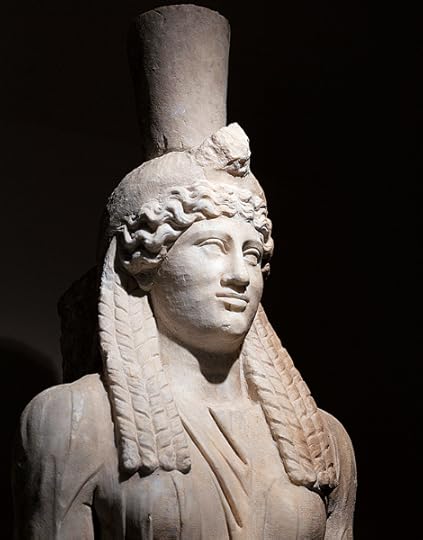 Sacred image of Isis from Brexiza, Greece, near Marathon
Sacred image of Isis from Brexiza, Greece, near MarathonAt Delphi, Best, Fairest; at Bambyce, Atargatis; among the Thracians and in Delos, Many-Named; among the Amazons, Warlike; among the Indians, Maia; among the Thessalians, Moon; among the Persians, Latina; among the Magi, Kore, Thapseusis [this name is hard to make out; possibly a specifically Persian name, possibly a magical name]; at Susa, Nania [possibly a syncretic Isis-Innana]; in Syrophoenicia, Goddess; in Samothrace, Bull-Faced; at Pergamum, Mistress; in Pontus, Immaculate; in Italy, Love of the Gods; in Samos, Sacred; at the Hellespont, Mystic; at Myndus, Divine; in Bithynia, Helen; in Tenedos, Name of the Sun; in Caria, Hekate; in the Troad and at Dindyma, Palentra [also unknown], Unapproachable, Isis; at Berytus, Maia; at Sidon, Astarte; at Ptolemais, Understanding; at Susa in the District of the Red Sea, Sarkounis [unknown]…
Thou Who interpretest first of all by the Fifteen Commandments [the word used in Greek is thesmoi, laws; I really want to know what these 15 Commandments or Laws of Isis are—so far, no one does know], Ruler of the World; Guardian and Guide, and Lady of the Mouths and Rivers and of Seas; Skilled in Writing and Calculations, Understanding; Who Also Bringest Back the Nile Over Every Country; the Beautiful Animal [probably, the Cow] of All the Gods; the Glad Face in Lethe; the Leader of the Muses; the Many-Eyed; the Comely Goddess in Olympus; Ornament of the Female Sex and Affectionate; Providing Sweetness in Assemblies; the “Lock of Hair” in Festivals; the Prosperity of Observers of Lucky Days; Harpocratis [possibly an expression meaning something like the “darling”] of the Gods; All-Ruling in the Procession of the Gods, Emnity-Hating, True Jewel of the Wind and Diadem of Life; By Whose Command Images and Animals of All the Gods, Having … of Thy Name, are Worshiped; O Lady Isis, Greatest of the Gods, First of Names, Io Sothis…
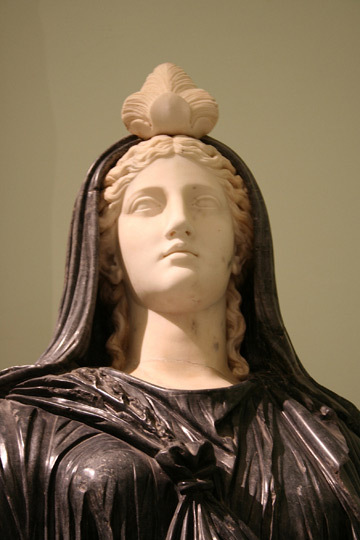 Roman Isis, from the 2nd century CE, in the Farnese Collection in Naples
Roman Isis, from the 2nd century CE, in the Farnese Collection in NaplesThou rulest over the Mid-Air and the Immeasurable; Thou devisest the weaving of . . . ; it is also Thy will that women in health come to anchor with men; all the elders sacrifice; all the maidens at Heracleopolis turn to Thee and dedicated the country to Thee; Thou art seen by those who invoke Thee faithfully; from Whom … in virtue of the 365 combined days; gentle and placable is the favor of Thy Two Ordinances [like the Commandments, I want to know!]; Thou bringest the Sun from rising unto setting, and all the Gods are glad; at the rising of the stars the people of the country worship Thee unceasingly and the other sacred animals in the sanctuary of Osiris; they become joyful when they name Thee; the spirits become Thy subjects; [the next few lines are very fragmentary] and Thou bringest decay on what Thou wilt and to the destroyed bringest increase, and Thou purifiest all things; every day Thou didst appoint for joy; Thou … having discovered all the … of wine providest it first in the Festivals of the Gods.
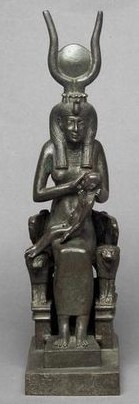 Isis with Horus upon Her lion throne
Isis with Horus upon Her lion throneThou becamest the discoverer of all things wet and dry and cold and hot, of which all things are composed; Thou broughtest back alone Thy Brother, piloting Him safely and burying Him fittingly; Leader of Diadems; Lady of Increase and Decay, Thou didst establish shrines of Isis in all cities for all time; and didst deliver to all human beings observances and a perfect year; and to all human beings in every place, Thou didst show . . . in order that all might know that Thou . . .
Thou didst establish Thy son Horus Apollon everywhere, the youthful Lord of the Whole World and for all time; Thou didst make the power of women equal to that of men; and in the sanctuary Thou didst . . . ; Thou, Lady of the Land, bringest the flood of rivers—in Egypt, the Nile, in Tripolis, the Eleutherus, in India, the Ganges; owing to Whom the whole exists through all rain, every spring, all dew, and snow and all the land and sea; Thou art also the Mistress of All Things Forever; Thou madest the . . . of the Dioscuri; Thou hast dominion over winds and thunders and lightnings and snows; Thou, the Lady of War and Rule, easily destroyest tyrants by trusty counsels; Thou madest great Osiris immortal and delivered to every country religious observances; likewise Thou madest immortal Horus who showed Himself a benefactor and good; Thou art the Lady of Light and Flames… [then the Invocation moves to a praise of Horus, and then it breaks off]
There is much to meditate on here. Perhaps you will be inspired, as I am, to call upon Her in some of these many names—and maybe even add your own to the list. “In Portland, Great of Magic, Queen Isis, Mysterious One…”
September 8, 2024
“Isis & Nephthys work magic for You with knotted cords”

I think I mentioned that Isis took, as an offering from me, a silver Knot of Isis when I visited Her Philae temple earlier this year. I had it on a chain around my neck when we took the boat over to the temple…and it was simply gone when we came back. It made me smile.
 The Knot of Isis is often of red material, but here’s a green one, the color of all good things in ancient Egypt
The Knot of Isis is often of red material, but here’s a green one, the color of all good things in ancient EgyptKnots are important symbols for Isis and of Her. Most of us are very familiar with the Knot of Isis, the knot amulet that resembles an ankh, but with the “arms” folded down. Learn more about it here. But there’s another reason Isis is connected with knots. And that’s because She is the Goddess of Magic—heka, in Egyptian—and very often, heka was and still is worked by the tying of knots.
Ancient Egyptian texts often describe working heka as weaving or knitting, which is just another form of knotting. The deceased person is said to be “knit together in the egg” prior to rebirth. Some texts say that the head of the deceased is “knit on.” The concept of weaving, knitting, or knotting magic—bringing the strands of magic together to create or preserve or repel—makes complete and utter sense to me. There is a delicacy and precision that the many types of knotting require that speaks to me as a very viable way to work magic.
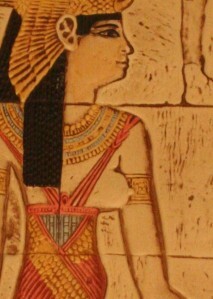 Note the knots in the straps of the Goddess’ garment as well as the little loop between Her breasts.
Note the knots in the straps of the Goddess’ garment as well as the little loop between Her breasts.The basic idea is simple enough: tied knots bind and untied knots release. Beyond that, knots can unite opposites and—since a knot secures things—protect.
Knot magic was well known in Egypt from an early period; an inscription in one of the pyramids says that Isis and Nephthys work magic for Osiris “with knotted cords.”
The Book of Coming Forth by Day (aka Book of the Dead) also gives several examples of the magical power of the knot. In one, knots are tied around the deceased to help them come into the presence of the Deities: “The four knots are tied about me by the guardian of the sky [. . .] the knot was tied about me by Nuet, when I first saw Ma’et, when the gods and the sacred images had not yet been born. I am heaven born, I am in the presence of the Great Gods.”
 A tjes knot as part of a necklace and the Goddess Bat or Hathor; surely this beautiful piece of jewelry was also protective
A tjes knot as part of a necklace and the Goddess Bat or Hathor; surely this beautiful piece of jewelry was also protectiveIn addition to these four knots, another text talks about seven knots, or tesut, that were tied about the deceased to protect them.
The power of the magical knot is in its ability to both unite and “surround” things. The tied knot is a symbol of the coming together of two things in perfect wholeness, a condition that promotes a positive outcome.
A passage in the Coffin Texts says that when the hair of Isis is knotted to the hair of Nephthys, the Two River Banks (that is, the land of the living and the land of the dead) are united. Tying a knot could also refer to sexuality; the perfect coming together of two people in an act of creation. We still “tie the knot” when we get married.
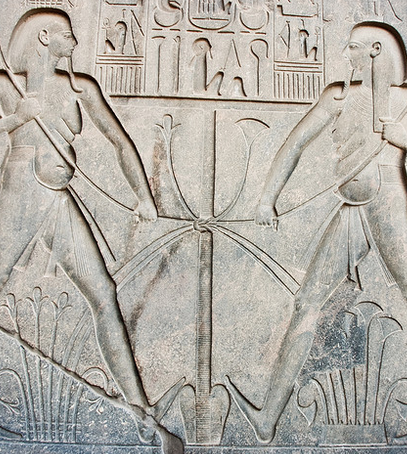 Hapi “tying the knot” to unite the Two Lands
Hapi “tying the knot” to unite the Two LandsFurthermore, because the two ends of the cord used in tying a magical knot symbolically go all the way around something, they “surround” that thing. Thus knot magic could be used to surroun” or bind an enemy—or even tie a curse to them.
In Spell 42 in Budge’s translation of the Book of the Dead, the knot appears as a kind of seed. The deceased is said to be “the knot within the tamarisk tree, beautiful of splendor more than yesterday.” This surely refers to Osiris within the tree prior to His resurrection.
And, of course, as you already know, the famous Knot of Isis is a very magical knot. In most cases, it is protective and associated with renewal and resurrection. As time passed, it became a must-have amulet for all mummies and was usually placed on the upper torso.
 A tjes knot used to secure a belt
A tjes knot used to secure a beltIf you’d like to work some protective knot magic for yourself, here’s a ritual, slightly adapted, from my Isis Magic (new edition coming in spring of 2026 from REDFeather Publishing!! Yay!) that you can use to do so.
In this rite, we are using the knots to surround with protection. We call upon Isis primarily, but also Nephthys, Neith, and Selket as the four Goddesses often found guarding the four corners of a shrine as well as the four Sons of Horus, Who in turn protect the canopic jars.
The Rite of the Tiet (the Knot of Isis) Isis protects!
Isis protects!About the Rite: In this ritual, you will magically tie a protective knot around yourself, or around anything or anyone you wish to protect. The ritual draws upon sources in the Book of Coming Forth by Day and is, in part, adapted from an ancient rite for consecrating the Tiet amulet.
Temple Arrangement: Altar at center; all tools on altar.
Ritual Tools: Nile water in Lotus Cup; flower petals from lotus, lily, or rose; Isis incense in censer; six pieces of fairly substantial red cord, each approximately one foot long (if you can’t find red cord that is thick enough, use white rope).
OpeningPurify and consecrate the temple and yourself according to the formulae of the House of Isis or any method you prefer. Return to the altar, take up the lotus (lily or rose) petals and elevate them.
Ritualist: O, you Souls of Life, Lotus Dwellers, Breathers, you of the Pure Air from the Wings of Isis, I have come for you. By the Blood, by the Power, by the Magic of Isis, establish yourselves within these petals. (Vibrating onto petals) ISET NEF!
Place some of the petals in the chalice.
Ritualist: (Addressing petals) I know you, you shining flowers. Your name is “Life Is In It”. Your name is “Protection”. Your name is “Peace Bringer”.
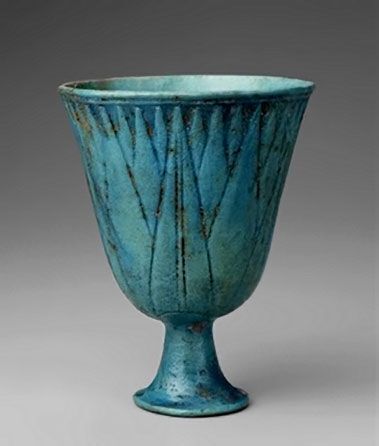 A beautiful Egyptian lotus cup
A beautiful Egyptian lotus cupPlace the pieces of cord upon the altar and anoint each of them with the Nile water with flower petals in it.
Ritualist: (Touching each piece of cord) Isis protects!
Invocation of the Powers of IsisNext, invoke the Goddess, raising your arms in Adoration.
Ritualist: I call the power of my Mighty Mother Isis. I call Her strength to me. I call upon the Power and the Peace of Isis, for I shall knot the cord, the Knot of Isis.
O Isis, my Mother, I call You!
I call You with the breath of my body (breathing out).
I call You with the beat of my heart (touching your chest).
I call You with the pulse of my life (touching your wrists).
I call You with the words of my mouth (touching your mouth).
I call You with the thoughts of my mind (touching your forehead).
I call You Power. I call You Life. I call You Protection.
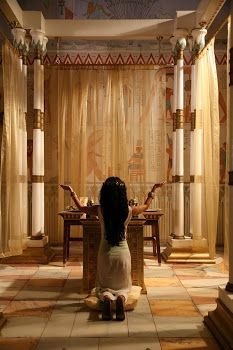
I call You, Isis!
Tying the KnotsTake up one of the pieces of red cord and move to the southeast corner of your ritual space. Holding the two ends of the cord in your hands, say:
Ritualist: You have Your Blood, O Isis. You have Your Power, O Isis. You have Your Magic, O Isis. The Blood of Isis and the Strength of Isis and the Words of Power of Isis shall be mighty to (state what you wish to protect) against all that would cause harm.
With strength and intention, tie a knot in the cord and set it in the southeast corner of the ritual space.
Ritualist: By the Power of Isis, I have knotted the cord.
Repeat this same procedure in the southwest, northwest, and northeast of the temple, above your head (leaving the cord on top of the altar), and upon the ground (leave the cord at the foot of the altar).
Stand west of the altar, facing east. Make the Sign of the Wings of Isis (raise and open your arms like wings).
Ritualist: O Isis and all You mighty Goddesses of Protection, I call upon You to guard (state what you wish to protect) as You did guard Osiris Himself, as You did guard Horus the Child.
 An exceptionally beautiful gold and amethyst necklace, secured by a clasp in the form of a knot
An exceptionally beautiful gold and amethyst necklace, secured by a clasp in the form of a knotIsis, Mighty Magician; Nephthys, Lady of Life; Neith, Primal Mother; Selket, Powerful One—tie the Knot of Isis against all harm. Keep it away! Restrain it! Let it not come near! O, Isis and all You Goddesses of Protection, grant Your peace and protection.
If you wish to meditate or do other work, this is an excellent time to do so.
ClosingIf this is a ritual for protection from some outside threat, leave the tied knots in your ritual space for as long as desired or needed and conclude the rite by making the Sign of the Wings of Isis at the altar and speaking the last line.
If this rite is worked simply to create peace for meditation, you may untie the knots when you are finished by simply going to each knot in the order you tied it and untying it, then returning each one to the altar.
 Use a simple, overhand knot in this ritual
Use a simple, overhand knot in this ritualRitualist: I have untied the knot. Be in peace, O You Blood and Power and Magic of Isis. Be in peace.
At the altar, make Sign of the Wings of Isis.
Ritualist: I thank You, Isis, in all Thy names of Protection. Hold me ever near You, bound by Your protective knots.
The rite is complete.
September 1, 2024
In Praise of Group Ritual
 Many of us are working solitary these days
Many of us are working solitary these daysCome, Hathoru, You Seven Hathors, You Egyptian Muses—come and help me to sing in praise of working rituals with groups of actual living humans.
These days, many of us are doing our rituals, spells, and meditations solitary. I’m reading an academic study of this particular phenomenon right now. (Yes, there are scholars who actually study us—though not that many.) Solitary ritual was a trend before the pandemic. But afterwards, it’s something of a landslide.
Why?
Sometimes, where we live doesn’t give us easy access to a like-minded community. Sometimes people have had a bad (sometimes very bad) experience with a group and are, as a result, “group-shy.” Sometimes, it’s just a lot of trouble to coordinate a get-together. If it’s formal ritual, then there’s rehearsal, too. But, even if it’s very informal ritual, you still need to have a certain level of comfort with each other—that is, you have to know each other at least a little to do ritual effectively. And that never comes automatically.
 When Egypt re-opened the Avenue of the Sphinxes at Luxor, they did group ritual—a boat procession. (Okay, Egyptian media were very careful to say the participants were “actors.”)
When Egypt re-opened the Avenue of the Sphinxes at Luxor, they did group ritual—a boat procession. (Okay, Egyptian media were very careful to say the participants were “actors.”)These are all reasonable reasons.
And yet.
 Music, often a part of group ritual
Music, often a part of group ritualIf you’ve ever been in a group ritual that really worked, you will know that there is nothing like it. When the stars align and the group is focused; when the Ways are open and all hearts are open; when the Goddess ARRIVES and the entire group ignites with Her energy—then, then, then the result is unlike what we can achieve in a solitary rite. There are times, during and after ritual, when I look at everyone in the circle with me and I deeply know how incredibly beautiful each and every one of them is. I see them through Her eyes for we have been together with Her, enfolded in Her wings, nourished by Her magic. Together.
Having been connected and in communication with Isis, we become connected and in communication with each other as well. (And this is one of the keys for when conflicts arise in groups, as they do. We have developed paths of communication and connection with each other, which we can then use to resolve issues. I’m not saying it’s easy; it’s not. But I am saying it’s possible. And I am saying it’s worth it. I’ve been in groups in which members went though a divorce and still managed to have the group remain stable, offering support to both members.)
In solitary ritual, our ritual actions tend to be more informal. Perhaps we light a candle, chant Isis’ name, and meditate or offer a prayer to Her. Often, this works beautifully and profoundly. It is the greater part of my own spiritual work.
 Getting ready for festival
Getting ready for festivalWhen we are doing group ritual, however, we are usually doing a rite with a more formal structure: cast-the-circle, call-the-quarters, invoke-the-Goddess, for instance. And that’s good because group ritual is about communication, human to Divine, Divine to human—and when it is group ritual—human to human and individual to group. By being a form with which everyone is familiar, the understanding and communication between all group members helps us easily build a sacred container for the group experience. In turn, that lets everyone relax into the form, enabling them to become more open, in both body and spirit. And this lets the magic flow, helping us more easily open to our perceptions of Her and connection with Her.
 Carriers of the sacred boat at Luxor
Carriers of the sacred boat at LuxorWhat’s more, the energy in group ritual is often more than the sum of its parts. Each individual brings their own innate magic to the rite. But combined, something happens. There is an alchemical blossoming of power and magic that makes it easier to connect with Deity—and/or accomplish the purpose of the rite. More than once, I’ve entered into a group ritual feeling low energy and maybe even grumpy for having to be there. But never once have I left feeling anything other than spiritually uplifted and grateful for having participated. Group energy can not only help carry a member through the rite, but can also replenish someone—who, like me—may be feeling depleted.
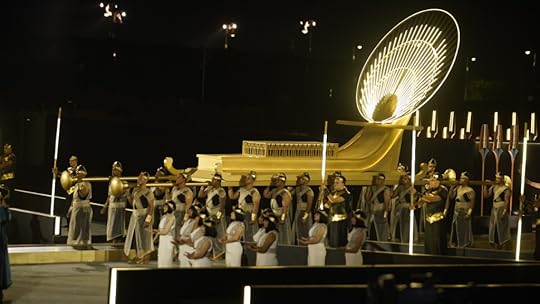 More celebration of the opening of the Avenue of the Sphinxes
More celebration of the opening of the Avenue of the SphinxesRitual like this helps us gain other benefits, too. Researchers have studied the effects of the basic components of ritual, such as chanting, drumming, and invocation, and found them to be beneficial to us both physically and mentally. I would add spiritually as well. Read more about why I think ritual itself is important here.
I have been fortunate throughout my entire magical life to have been able to find people with whom to work magic, with whom to do group ritual. Some of us have been friends for a very long time and I love them all dearly. But some of us are new friends and I’m just getting to know them. For instance, some of my friends, new and old, are working together on a festival—the Return of the Wandering Goddess (Hathor! Sakhmet!)—for next summer solstice. And I can’t wait to do more group ritual with them all.
 Modern Egyptians put wheels on their sacred boats!
Modern Egyptians put wheels on their sacred boats!



